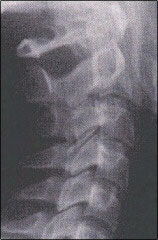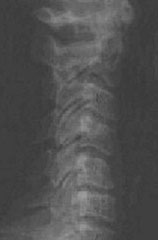Car Accidents
What Happens in a Car Accident?
Whiplash
 Injuries to the neck caused by a rapid movement of the head backward, forward, or side to side, is referred to as “Whiplash.” Whether a result of a car accident, sport, or work injury, whiplash or other neck injuries warrant a thorough chiropractic check-up. The biggest danger with these injuries is that the symptoms can take years to develop. Too often people don’t seek treatment until more serious complications develop. Even after whiplash victims settle their insurance claims, between 39%-56% report they still suffer with symptoms two years later.
Injuries to the neck caused by a rapid movement of the head backward, forward, or side to side, is referred to as “Whiplash.” Whether a result of a car accident, sport, or work injury, whiplash or other neck injuries warrant a thorough chiropractic check-up. The biggest danger with these injuries is that the symptoms can take years to develop. Too often people don’t seek treatment until more serious complications develop. Even after whiplash victims settle their insurance claims, between 39%-56% report they still suffer with symptoms two years later.
In the past, a typical whiplash injury where no bones were broken, was hard to document. Soft tissue injuries do not show up on x-ray and insurance companies would deny coverage. Literally adding insult to injury, the patient suffering all too real pain was considered to be a fraud, a liar, or at best a hypochondriac. New imaging devices (CAT Scans, Magnetic Imaging, and Ultra-Sound) may now show soft tissue injury and now insurance companies cover most whiplash injuries.
When no bones are broken and the head doesn’t strike the windshield, typical symptoms are as follows: 92% complain of neck pain, which typically starts two hours up to two days after the accident. This is often the result of tightened muscles that react to either muscle tears or excessive movement of joints from ligament damage. The muscles tighten in an effort to splint and support the head, limiting the excessive movement.
About 57% of those suffering from whiplash complain of headaches. The pain may be on one side or both, on again off again or constant, in one spot or more generalized. These headaches, like the neck pain, are often the result of tightened, tensed muscles trying to keep the head stable and, like tension headaches, they are often felt behind the eyes.
Shoulder pain often described as pain radiating down the back of the neck into the shoulder blade area, may also be the result of tensed muscles, accounting for 49% of injuries caused by whiplash.
Muscle tears are often described as burning pain, prickling or tingling. More severe disc damage may cause sharp pain with certain movements, with or without radiation into the arms, hand and fingers, which are relieved by holding your hand over your head.
Whiplash Symptoms
The following lists the most common whiplash symptoms as well as their rate of occurrence. If you experience any of these symptoms, play it safe and get a chiropractic check up.
- Neck pain and/or stiffness 92%
- Headache 57%
- Fatigue 56%
- Shoulder pain 49%
- Anxiety 44%
- Pain between the shoulder blades 42%
- Low back pain 39%
- Sleep disturbance 39%
- Upper limb paresthesia 30%
- Sensitivity to noise 29%
- Difficulty concentrating 26%
- Blurred vision 21%
- Irritability 21%
- Difficulty swallowing 16%
- Dizziness 15%
- Forgetfulness 15%
- Upper limb pain 12%
- Upper limb weakness 6%
- Ringing in the ears 4%
- Pain in the jaw or face 4%+
Mechanics of a whiplash injury
 Whiplash is most commonly received from being struck from behind, whether from something as light as a fender bender or from something as powerful as a football tackle. When the head is suddenly jerked back and forth beyond its normal limits, the muscles and ligaments supporting the spine can be over-stretched or torn.
Whiplash is most commonly received from being struck from behind, whether from something as light as a fender bender or from something as powerful as a football tackle. When the head is suddenly jerked back and forth beyond its normal limits, the muscles and ligaments supporting the spine can be over-stretched or torn.
In a rear end collision for example, whiplash can be divided into four basic phases:
Phase 1
During Phase 1 the car is first pushed or accelerated forward within milliseconds. Your car is essentially pushed out from under you and your back loads the seat. High shearing forces develop within the neck and your spinal curves straighten and compress. High pressures develops within the brain and shearing forces on the brain stem.
Phase 2
Upward rise of your neck as your head snaps into full extension over the headrest and collapses it. This acts as a fulcrum and TMJ injury is possible with high compression within the joint and some of the muscles and ligaments are stretched or torn in the neck.
Phase 3
The head begins its forward motion as the torso descends into the seat. Seat back bounce increases your velocity 30-70% greater than that of your car. Slack in the seatbelt shoulder harness begins to tighten. Your neck muscles, in a reflex action, contract to bring the head forward as they are thought to be in extension (phase 2), in an attempt to prevent excessive injury. But, because the head is already traveling in a forward direction as the car decelerates, there is an overcompensation.
Phase 4
This violently rocks the head forward, overstretching more muscles and ligaments in the back of the neck. Full deceleration of the head, neck and torso is aggravated by the shoulder harness. High tension and shear forces in the spine can cause the soft pulpy discs between the vertebrae to bulge, tear, or rupture. Vertebrae can be forced out of their normal position, reducing range of motion (Vertebral Subluxation.) The brain stem, spinal cord and nerve roots get stretched, irritated, and choked. If the victim is not properly restrained the occupant’s head may strike the steering wheel or windshield, causing a concussion.
Risk Factors
The resulting instability of the spine and soft tissues are noteworthy and depend on several factors.
- Rear direction impact.
- Limited range of motion; neurological symptoms after the crash
- Ligamentous instability after the accident.
- Degenerative disease, headaches or neck injury or pain prior to the crash.
- Vehicle size. When both are equal, even an 8 mph collision produces two times the force of gravity or a 2-G acceleration of the car, and a 5-G acceleration of the head. This magnification of the force gives rise to the name, Whiplash.
- Headrest position. This can make an injury much worse if too low, and even at the right height, it must be close enough to catch the head in time (about 2 inches). A seat that is reclined too far will increase this distance, as will poor posture and driving habits if leaning forward. Some older vehicles (trucks, vans) do not have head restraints, adding insult to injury.
- The position of the head at impact. When turned to the side, for instance, it can only move about half as far as a straightforward position. Hence, all the G forces are localized to one side of the spine, substantially increasing the severity of injuries.
- Age plays an important role because as the body becomes older, ligaments become less pliable, muscles weaker and less flexible, and decreases in range of motion.
- Women and children seem to be injured more seriously than men. This is most notable due to the fact that they tend to have smaller necks. They may also be too close to the steering wheel, airbag and/or have improper fitting shoulder harnesses.
- Pre-existing health problems such as arthritis, lend to the severity of the injuries.
- The use of the seat belt and shoulder harness.
- Non-awareness of the impact.
- Non-failure of the seat back.
Myths
- Low Speed Rear Impact Crashes don’t cause injuries.
- Injuries heal in 6-12 weeks.
- Litigation has an effect on the patient’s recovery.
- The patient’s pre-injury psychological makeup affects recovery.
- Greater vehicle damage=greater occupant injury.
- Accident reconstructionists can predict injury potential.
Crash Facts
- In a series of recent human volunteer crash tests of low speed rear impact collisions, it was reported that the threshold for cervical spine soft tissue injury was 5 mph.
- Most injuries occur at speeds below 12 mph.
- The peak acceleration of the head is greater than the peak acceleration of the vehicle.
- A 5 mph delta V crash typically produces about 10-12 g of acceleration of the occupant’s head.
- Other reports have shown that crashed cars can often withstand collision speeds of 10 mph or more without sustaining damage. Thus: the concept of “no crush, no cash” is simply not valid.
- Recent epidemiological studies have shown that most injury rear impact accidents occur at crash speeds of 6 mph to 12 mph–the majority at speeds below the threshold for property damage to the vehicle.
- A number of risk factors in rear impact accident injury have now been verified including: rear (vs. other vector) impact, loss of cervical lordotic curve, preexisting degenerative changes, the use of seat belts and shoulder harness, poor head restraint geometry, non-awareness of the impending collision, female gender, and head rotation at impact.
- The notion of litigation neurosis has been rather definitively dispelled.
- Once thought to suggest minimal injury, a delay in onset of symptoms has been shown to be the norm, rather than the exception.
- Mild traumatic brain injury can result from whiplash trauma. Often the symptoms are referred as the post concussion syndrome. This condition, often maligned in the past, has now been well-validated in recent medical literature.
- A recent outcome study of whiplash patients reported in the European Spine Journal found that between one and two years post injury, 22% of patients’ conditions deteriorated. This second wave of symptoms has been observed by others as well.
- Radanov et al. followed whiplash patients through time and reported that 45% remained symptomatic at 12 weeks, and 25% were symptomatic at 6 months. Other researchers have reported time to recovery in the most minor of cases at 8 weeks; time to stabilization in the more severe cases at 17 weeks; and time to plateau in the most severe categories as 20.5 weeks. Thus, the notion that whiplash injuries heal in 6-12 weeks is challenged. (Incidentally, there never has been any real support for this common myth.)
- Each year, 1.99 million Americans are injured in whiplash accidents.
- Of the 31 important whiplash outcome studies published since 1956 (19 published since 1990 pooling patients from all vectors of collision (I. e., rear, frontal, and side impacts), a mean of 40% still symptomatic is found. For rear impact only, a mean of 59% remain symptomatic at long-term follow-up.
- Although estimates vary, about 10% of all whiplash victims becomes disabled.
- The Quebec Task Force on Whiplash-Associated Disorders has been criticized on the basis of potential bias, study design, the use of ambiguous and misleading terminology, and for developing conclusions that are not supported by the literature.
- The chiropractic profession has developed its own guidelines for management of whiplash patients.
Most injuries don’t show on x-rays
This loss of normal cervical curve is the result of the cervical acceleration/deceleration syndrome, and can be responsible for many positive orthopedic and neurological examination findings contributing to the patients symptomotology. X-rays cannot demonstrate microscopic, tears nor show inflammation in the soft tissue (ligaments, tendons, muscle, cartilage, etc) which is one of the leading causes of the pain and soreness that you feel. X-rays are the most cost effective study to rule out ligament insufficiency, bone pathology, and vertebral misalignment.

Normal Cervical Curve X-ray

Reverse (kyphotic) Curve X-Ray
Chiropractic
Chiropractic treatment is one of the only proven effective forms of care in the treatment chronic whiplash related injuries. Through the use of carefully controlled pressures directed at the spine and various physical therapy modalities, combined with that of exercise and nutrition, whiplash sufferers have a better outcome. This is also known as chiropractic rehabilitation, and is the unique domain of the chiropractic physician.
Studies have demonstrated that without proper movement within the fixated spinal joints, osteoarthritis of the spine and nerve root complications may be accelerated.
Children
Whiplash associated disorders do not exclude children. In fact, children involved in automobile accidents are often neglected in these types of injuries when in actuality, they suffer from the same symptoms and are at a greater risk for damages. Adding fuel to the fire, a number of insurance companies object to paying for the care of children when the literature shows that they are at two-thirds the risk of adults.
Accident Plan
Motor vehicle Accidents are a leading cause of accidental death and injury in the nation. If you, or someone you know, has been injured in auto accident, here are the steps you should follow:
- Stop your car and Turn off your engine to minimize the risk of fire.
- Get out of your vehicle. Although you must remain on the accident scene, remove yourself from further danger by getting out of your vehicle and out of traffic. If possible, collect information about the accident at the scene, or as soon after as is practical.
- Call 911 for police or medical assistance. Even if there are no injuries, assistance may be necessary to clear the accident scene, handle traffic, and file an accident report. Tell the police if any party is injured or has left the scene of the accident. If the police fail to arrive at the scene, go to the local police department to file the appropriate information. If the other vehicle left the scene of the accident, it is very important to give the police whatever information you were able to obtain (license plate number, description of vehicle and driver).
- Exchange Information no matter who is at fault. Exchange names, addresses and insurance information, and help the injured at the scene of an accident. Include time and place of accident, weather and road conditions, and other circumstances of the accident. Of those involved, including other drivers, passengers, witnesses, get their driver’s license number, insurance company and policy number, vehicle make and model, and license plate number of other involved vehicles. Also obtain the name, department and badge numbers of responding police officers and a copy of the police report. If it is safe to do so, move vehicles off busy roads and set up flares.
- Don’t sign anything except a ticket, citation or report issued by police. Never sign anything else at the accident scene. Signing some documents jeopardizes your rights.
- Obtain medical attention as soon as possible. Shock and trauma can mask serious injuries. Following first-aid treatment you may receive at the scene, follow up with your doctor of chiropractic for a complete examination, even if you “feel” fine. EMS and ER technicians do not diagnose the vertebral subluxation complex, nor recognize soft tissue injuries as life threatening. Remember that accidents with little or no damage can be more hazardous than accidents with damage!
- Call your insurance company and give them all the information you have collected. If you were injured or if your car was damaged, your insurance company needs to be notified “promptly” in order to conduct their investigation into the claim and coverage. Your claim may be denied by the insurance company if there is late or no notice. For this reason, it is wise to follow up with a written notice.
- Don’t discuss the accident. Except for giving necessary details to police, medical personnel, your insurance company, or your attorney, don’t discuss the accident…especially with insurance companies or lawyers representing others. Refer inquiries to your insurance company, your doctor, or your attorney.
- File a report with the police, if not already done. You can obtain an accident report from the police department or our office.
Airbags
 The significance of air bags, while providing a means for reducing the risk of serious or fatal injury that current air bags pose to identifiable groups of people, e.g., people who cannot avoid sitting extremely close to air bags, people with certain medical conditions, and young children. The benefits are substantial; current air bags had saved about 2,620 drivers and passengers, as of November 1, 1997. However, those air bags had also caused the death of 87 people in low speed crashes, as of that same date. Most of those people were unbelted or improperly belted. Although vehicle manufacturers are beginning to replace current air bags with new air bags having some advanced attributes, i.e., attributes that will automatically avoid the risks created by current air bags, an interim solution is needed now for those groups of people at risk from current air bags in existing vehicles.
The significance of air bags, while providing a means for reducing the risk of serious or fatal injury that current air bags pose to identifiable groups of people, e.g., people who cannot avoid sitting extremely close to air bags, people with certain medical conditions, and young children. The benefits are substantial; current air bags had saved about 2,620 drivers and passengers, as of November 1, 1997. However, those air bags had also caused the death of 87 people in low speed crashes, as of that same date. Most of those people were unbelted or improperly belted. Although vehicle manufacturers are beginning to replace current air bags with new air bags having some advanced attributes, i.e., attributes that will automatically avoid the risks created by current air bags, an interim solution is needed now for those groups of people at risk from current air bags in existing vehicles.